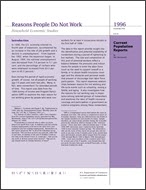Reasons People Do Not Work: 1996
Reasons People Do Not Work: 1996
Introduction
In 1996, the U.S. economy entered its fourth year of expansion, accompanied by an increase in the rate of job growth and a decline in unemployment.1 From September 1992, when the expansion began, to August 1996, the national unemployment rate decreased from 7.6 percent to 5.1 percent, and the percentage of civilians who were employed increased from 63.0 percent to 65.0 percent.2
Even during this period of rapid economic growth, of course, not all people of working age (15 years and over) had jobs. Many, in fact, were nonworkers3 for extended periods of time. This report uses data from the 1996 Survey of Income and Program Participation (SIPP) to examine the main reason for not working given by people who were nonworkers for at least 4 consecutive months in the first half of 1996.4
The data in this report provide insight into the identification and potential availability of nonworkers during a period of tightening labor markets. The size and composition of this pool of potential workers reflect a balance between the pressures and inducements for people to enter the labor force (such as the need to support oneself or a family, or to obtain health insurance coverage) and the obstacles and personal needs that prevent or discourage their labor force participation. This report examines relationships between reasons for not working and life-cycle events such as schooling, raising a family, and aging. It also investigates how the reasons for not working vary in importance among selected groups of nonworkers and examines the rates of health insurance coverage and participation in government assistance programs among these nonworkers.
_______________
1 William C. Goodman and Randy E. Ilg, “Employment in 1996: Jobs Up, Unemployment Down,” Monthly Labor Review, Vol. 120, No. 2, February 1997, p.1.
2 U.S. Bureau of Labor Statistics, Labor Force Statistics from the Current Population Survey, generated by Mai Weismantle, //146.142.4.24/cgi-bin/surveymost?bls,(August 20, 1999).
3 A nonworker is someone who is either (a) unemployed (on layoff from a job, or without a job but actively seeking employment) or (b) not in the labor force (not employed and not seeking employment). Nonworkers in this report answered “No” to all of the following survey questions: “Did you have at least one paid job, either full or part time, at anytime in the past 4 months? Count active duty in the Armed Forces as a paid job.”; “Did you do any work at all that earned some money?”; “Did you do any unpaid work in a family business or farm?”
4 SIPP is a longitudinal survey that follows the same individuals over time. The survey is conducted in waves of 4 months’ duration. Data are collected from one-fourth of the sample members in each month of a wave. Sample members are asked about activities during the 4 months prior to the interview, which is known as the “reference period.” These data were collected during wave 1 of the 1996 SIPP; interviews were conducted from April-July 1996 in four separate rotation groups. The nonworkers who are the focus of this report are people who did not work at any time in the 4 months prior to the month they were interviewed, periods which ranged from December 1995 through March 1996 to March 1996 through June 1996. Some were members of the country’s labor force for at least part of the 4 months, even though they did not work, because they were on layoff from jobs, or they had been looking for work.
Others in Series
Publication
Publication
Publication






